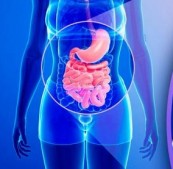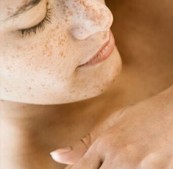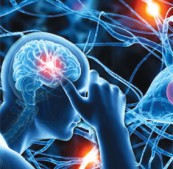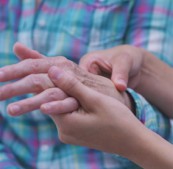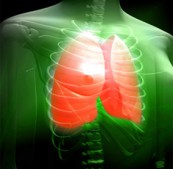Hemorrhoids (Piles)

Hemorrhoids, also called piles, are vascular structures in the anal canal. They become a disease when swollen or inflamed; the unqualified term "hemorrhoid" is often used to refer to the disease. The signs and symptoms of hemorrhoids depend on the type present. Internal hemorrhoids often result in painless, bright red rectal bleeding when defecating. External hemorrhoids often result in pain and swelling in the area of the anus. If bleeding occurs it is usually darker. Symptoms frequently get better after a few days. A skin tag may remain after the healing of external hemorrhoid.
While the exact cause of hemorrhoids remains unknown, a number of factors which increase pressure in the abdomen are believed to be involved. This may include
- constipation
- diarrhea and
- sitting on the toilet for a long time.
Hemorrhoids are also more common during pregnancy. Diagnosis is made by looking at the area. Many people incorrectly refer to any symptom occurring around the anal area as "hemorrhoids" and serious causes of the symptoms should be ruled out.
Brief with types
The two types of hemorrhoids are External and Internal. These are differentiated by their position with respect to the dentate line (Pectinate line). Some persons may concurrently have symptomatic versions of both. If pain is present, the condition is more likely to be an anal fissure or an external hemorrhoid rather than an internal hemorrhoid.
Internal
Internal hemorrhoids originate above the dentate line. They are covered by columnar epithelium, which lacks pain receptors.They were classified in 1985 into four grades based on the degree of prolapse
- Grade I: No prolapse, just prominent blood vessels
- Grade II: Prolapse upon bearing down, but spontaneous reduction
- Grade III: Prolapse upon bearing down requiring manual reduction
- Grade IV: Prolapse with inability to be manually reduced.
External
External hemorrhoids occur below the dentate or pectinate line. They are covered proximally by anoderm and distally by skin, both of which are sensitive to pain and temperature.
Signs & Symptoms(Lakshana):
In about 40% of people with pathological hemorrhoids, there are no significant symptoms. Internal and external hemorrhoids may present differently; however, many people may have a combination of the two. Bleeding enough to cause anemia is rare, and life-threatening bleeding is even more uncommon.
In External Haemorrhoids
If not thrombosed, external hemorrhoids may cause a few problems. However, when thrombosed, hemorrhoids may be very painful. Nevertheless, this pain typically resolves in two to three days. The swelling may, however, take a few weeks to disappear. A skin tag may remain after healing. If hemorrhoids are large and cause issues with hygiene, they may produce irritation of the surrounding skin, and thus itchiness around the anus.
In Internal Haemorrhoids
Usually present with painless, bright red rectal bleeding during or following a bowel movement. The blood typically covers the stool (a condition known as hematochezia), is on the toilet paper, or drips into the toilet bowl. The stool itself is usually normally coloured. Other symptoms may include:
- mucous discharge,
- a perianal mass if they prolapse through the anus,
- itchiness, and
- fecal incontinence.
Internal hemorrhoids are usually only painful if they become thrombosed or necrotic
Causes (Nidan):
The exact cause of symptomatic hemorrhoids (ARSAS) is unknown. A number of factors are believed to play a role, including:
- irregular bowel habits (constipation or diarrhea),
- lack of exercise,
- nutritional factors (low-fiber diets),
- increased intra-abdominal pressure (prolonged straining, ascites, an intra-abdominal mass, or pregnancy),
- genetics,
- an absence of valves within the hemorrhoidal veins, and
- aging.
Other factors believed to increase risk include
- obesity,
- prolonged sitting,
- a chronic cough, and
- pelvic floor dysfunction.
Squatting while defecating may also increase the risk of severe hemorrhoids. Evidence for these associations, however, is poor. During pregnancy, pressure from the fetus on the abdomen and hormonal changes cause the hemorrhoidal vessels to enlarge. The birth of the baby also leads to increased intra-abdominal pressures. Pregnant women rarely need surgical treatment, as symptoms usually resolve after delivery.
Treatments :
Acharya Sushruta has mentioned four-fold treatment for Arshas –
- Drug therapy (Bheshaja karma),
- Surgical therapy (Shastra karma),
- Chemical cauterization (Kshara karma) and
- Cauterization (Agni Karma); on the basis of Dosha involvement and the stage of Arshas.
However, the basic management principle for every disease in Ayurveda is to avoid the causative factor, which helps either in breaking etiopathogenesis at basic level of the disease. Sushruta, the Father of Indian surgery had a deep clinical understanding of this subject. According to doshas following treatment is given:
- Vatarsha -Snehana, Swedana, Vamana, Virechana, Asthapana and AnuvasanaBasti
- Pittarsha - Virechana
- Kaphjarsha - Aharadravyamixed withShunthiandKulattha.
- Raktarsha - Shamana
- Sannipatikarsha - mixed treatment of all Dosha.
And other treatment include
- Hot Sitz Bath
- Use of Laxatives
- Deepana Pacahana Oushadhi Usage
Additional Treatment
- Kashar sutra ligation: It is a procedure in which medicated herbal coated thread are applied onto internal and external piles mass within 5-7 days withered piles mass falls off. Cure rate-97%
- Chedan karma: A number of surgical excision techniques may be used if conservative management and simple procedures fails.All are associated with some degree of complications including bleeding, infection, anal strictures and urinary retention, due to the close proximity to the rectum to the nerves that supply the bladder. There may also be a small risk of fecal incontinence, particularly of liquid, with rates reported between 0-28 percent.
- Agni karma: A number of cauterization methods have been shown to be effective for hemorrhoids, but are usually only used when other methods fail. This procedure can be done using electrocautery, infrared radiation, laser surgery, or cryosurgery. Infrared cauterization may be an option for grade 1 or 2 disease. In those with grade 3 or 4 disease re-occurrence rates are high
- Ksharkarma: Involves the applying of a sclerosing agent, such as apamarg kshar snuhi kshar, into the hemorrhoid. This causes the vein walls to collapse and the hemorrhoids to shrivel up. The success rate four years after treatment is ~70%
Prevention
The Diets and habits to be avoided are,
- Habitual intake of heavy, sweet, cold, and food items which causes obstruction in the channels of circulation
- Excessive exercise or physical inactivity
- Anger,
- Abnormal insertion of enema nozzle
- Intake of the meat of emaciated animals, dried meat and putrefied meat;
- Lack of sexual act or excessive indulgence in sexual act
- Anxiety
- Frequent injury to anal region
- Intake of pastries and preparation of milk, rice and sugar, whey
- Forceful elimination of natural urge of defecation,flatus and micturition,
- Too much straining during passing the stool
- Envy
- Rubbing anus by using grass, rags, clods etc
- Consuming food items prepared from sesame seed and jaggery
- Undesirable suppression of natural urge of defecation,flatus and micturition, which should be evacuated as soon as manifested
- Sorrow
- Use of rough, uneven and inflexible seats
- Excessive and habitual intake of food items prepared from black gram, sugarcane juice, oil cake, dried or frozen vegetables, vinegar, garlic, cream prepared from milk or cream obtain from curd, thick or thin lotus stalk, germinated corns and pulses;
- Freshly harvested grains and tender radish
- Excessive pressure applied during the process of delivery
- Mental inertia
- Travelling in uncomfortable vehicle
- Excess intake of fruits which are heavy for digestion,
- Use of uncooked pickle and vegetables, fat obtain from muscle, meat of head and legs of animals, consuming stale food, putrid food items and food prepared by the mixture of verities of items, like rice, pulses and meat etc
- Miscarriage
- Excessive riding Intake of curd which is not properly formed and wrongly fermented wines, drinking unhygienic and heavy water
- Pressure of the pregnant uterus rubbing of anal region Intake of unctuous food substances in excess
- Abnormal delivery Intake of incompatible food combinations
- Frequent application of cold water
- Eating too little
- Continued excessive strain, squatting position
- Eating before previous food is digested,
- Sleep during day time
A number of preventative measures are recommended, including
- Avoiding straining while attempting to defecate,
- Avoiding constipation and diarrhea either by eating a high-fiber diet
- Drinking plenty of fluid or by taking fiber supplements, and
- Getting sufficient exercise.
- Spending less time attempting to defecate,
- Avoiding reading while on the toilet
- Losing weight for overweight persons
- Avoiding heavy lifting
